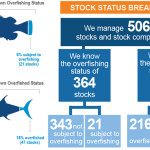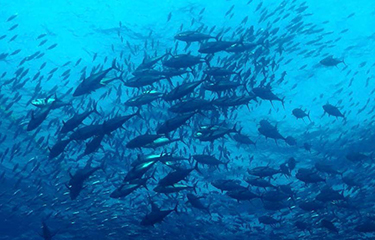The International Seafood Sustainability Foundation’s (ISSF) latest “Status of the Stocks” report for global tuna fisheries found the sustainability of global tuna stocks has remained flat since its last report in March.
The latest report found that 85 percent of the world’s commercial tuna catch comes from stocks at “healthy” levels of abundance, the same amount the ISSF reported over six months ago. The level of tuna coming from overfished stocks also remained flat at 11 percent, and 4 percent of the catch is coming from stocks at an “intermediate” level of abundance.
ISSF reported that no individual stock statuses have changed in any meaningful way since the March report, and the new report contains new stock assessment results from the Western Pacific bigeye and yellowfin, North Pacific albacore, North Atlantic albacore, and Southern bluefin stocks – none of which changed.
“The lack of substantial changes in stock status between report periods highlights the value of continuous scientific assessments to inform stock-management decisions,” ISSF said.
Of the overfished stocks, Mediterranean albacore, Indian Ocean bigeye, and Indian Ocean yellowfin stocks continue to be overfished and subject to overfishing. The ISSF also reported that Pacific Ocean bluefin tuna is overfished, but is not subject to overfishing.
Bigeye and yellowfin in the Indian Ocean have been the subject of ongoing debate at the Indian Ocean Tuna Commission (IOTC), the regional fishery management organization (RFMO) in charge of stocks there.
Environmental organizations have pressured the IOTC to take action on the bigeye and yellowfin stocks, but the latest meeting in May once again failed to reach any agreement on new yellowfin quotas, but did take some steps to rein in bigeye catch.
Other RFMOs have also taken action since the ISSF’s last update in March. The Inter-American Tropical Tuna Commission established new rules on fish aggregate device (FAD) fisheries in the Easter Pacific Ocean, and adopted a new harvest strategy and harvest control rule for Nort Pacific albacore.
The Commission for the Conservation of Southern Bluefin Tuna also adopted recommendations on a total allowable catch for Southern bluefin based on the outcome of the stock’s management procedure.
Overall, the new Status of the Stocks report has few notable changes from March. The abundance of spawning biomass levels, globally, remains unchanged: 61 percent are at a healthy level, 22 percent are at an intermediate level, and 17 percent are overfished. The totals are still a decline compared to ISSF reports in 2022.
Photo courtesy of Jeff Muir/ISSF







